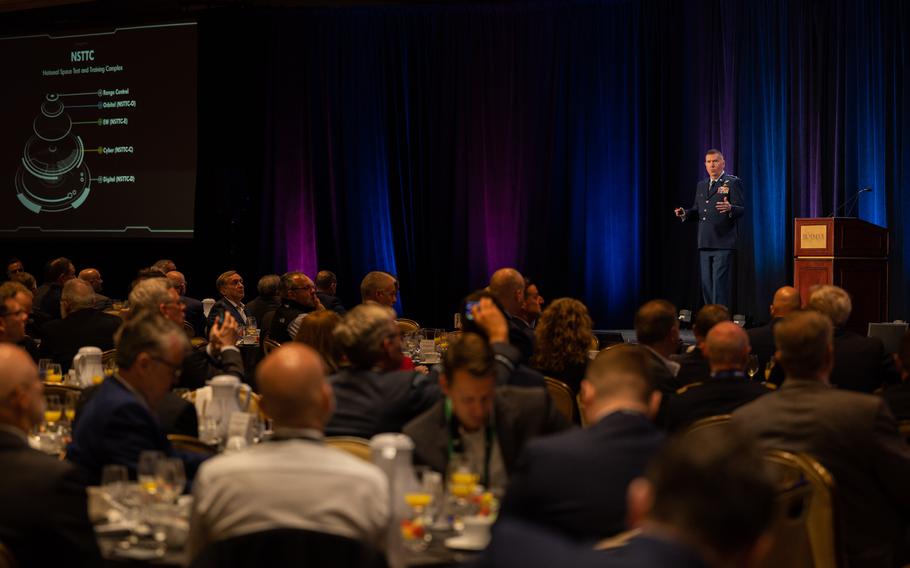
U.S. Air Force Maj. Gen. Shawn N. Bratton, Commander of Space Training and Readiness Command, gives remarks as the featured speaker for the 38th Space Symposium Satellite Forum Breakfast in Colorado Springs, Colo., on April 19, 2023. (Ethan Johnson/U.S. Space Force)
COLORADO SPRINGS, Colo. (Tribune News Service) — The U.S. needs to work faster to deter and detect threats in space, the secretary of the Air Force said Wednesday in Colorado Springs as he announced plans to speed up research and development efforts.
“Space isn’t just a warfighting domain, it is the warfighting domain,” said Secretary Frank Kendall to an international audience gathered at Space Symposium.
Kendall said he planned to back legislation that would allow the research and development of projects for space defense to start without waiting for Congressional budgetary approval. He noted the early phases of projects are not very expensive and could help the U.S. stay competitive as China invests heavily in space. For example, a Chinese satellite has successfully moved another satellite out of its orbit.
“We live in both dynamic and dangerous times,” Kendall said.
Space Force Gen. Chance Saltzman also called for speedy innovation and greater investment into training, saying he asked for $300 million in the 2024 Department of Defense budget to improve training and testing infrastructure, including better simulations. Some of that investment could be seen in Colorado Springs, home to Peterson and Schriever Space Force bases.
“Now is not the time to allow for any measure of complacency,” said Saltzman, who called on the Space Force, industry partners and allies to pivot to meet the new challenges.
A big part of change can be attracting and retaining new talent that will drive real change and innovation, he said. While the Space Force is almost four years old, one-third of the enlisted guardians have only served in Space Force.
To prepare them to counter potential attacks, Lt. Gen. Stephen Whiting said that guardians can complete some exercises in simulation mode on the systems they use every day, but rarely can those systems emulate current threats.
He would like them to have simulations that show them the indications of a satellite under attack, such as jamming that block necessarily communications, and allow them to respond.
“We have struggled to do that. ... We owe our guardians and airmen better training,” he said.
Saltzman said in the most recent large-scale space training exercise, 14 companies participated to help understand what the Space Force is looking to achieve.
The Space Force also needs to improve its ability to find and track objects in space, Saltzman said, noting that after a rocket broke up it took a couple of days to put information together about the event.
“There are some challenges with how long it takes to get the data and make sense of it,” he said.
The objects Space Force will need to manage is set to multiply as the U.S. sends up hundreds of new satellites as part of an effort to diversify U.S. missile warning and missile tracking, a focus for Buckley Space Force Base.
At the same time, The Washington Post reported earlier this month that China is planning to launch 13,000 new satellites.
Still, Kendall said the U.S. is not in a cold war with China because of the global economic ties that exist and while war is not impossible, deterrence can succeed.
“The economic consequences of aggression may not be worth the cost,” Kendall said.
(c)2023 The Gazette (Colorado Springs, Colo.)
Visit at www.gazette.com
Distributed by Tribune Content Agency, LLC.